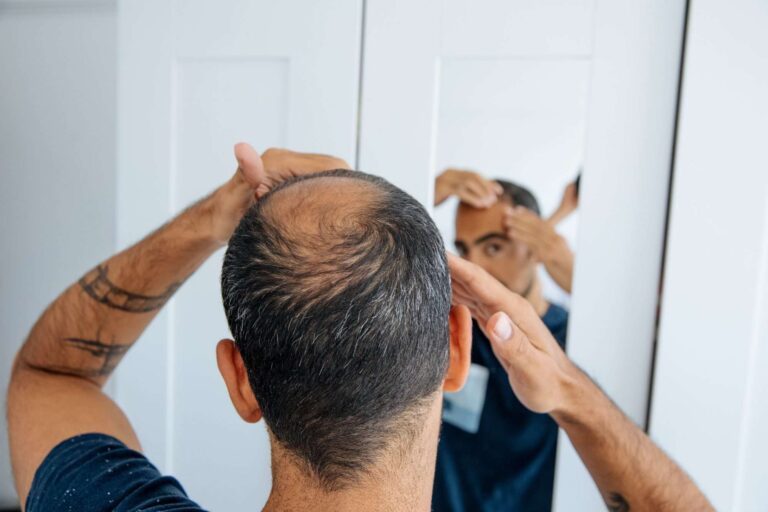Wondering if oral minoxidil is right for you to treat hair loss? Dermatologists may recommend the FDA-approved topical medication minoxidil to people with hair loss. Another form of minoxidil, high-dose minoxidil tablets, is FDA-approved to treat high blood pressure. However, the tablets are being investigated for off-label use, that is, when they are prescribed for purposes other than those approved by the FDA.
Some healthcare professionals prescribe low-dose oral minoxidil as an off-label treatment for hair loss, and studies have found that this treatment is generally effective. Here are some precautions to take if you use oral minoxidil to treat hair loss, and how to discuss it with your dermatologist.
I started using low-dose oral minoxidil for my hair loss after noticing side effects from high-dose oral minoxidil used to treat high blood pressure. In clinical trials of Loniten (oral minoxidil for blood pressure), about 80% of patients experienced hirsutism (growing longer, thicker, and darker body hair). During clinical trials, hair regrowth was usually seen 3-6 weeks after treatment began.
Some researchers suggest that oral minoxidil may be used in the following cases:
It is easier and more convenient to take the medication orally You may be able to save money with an oral minoxidil prescription You don’t want any residue left in your hair
Larger studies are needed to further support the effectiveness of oral minoxidil for treating hair loss. Still, some researchers believe that oral minoxidil is generally effective.
One study tracked the results of 51 patients with androgenic alopecia (AGA), commonly known as female or male pattern baldness, for three years. Results showed that 65% of subjects experienced scalp hair growth and 27% experienced a reduction in hair loss.
In another study, participants with AGA were treated with either topical or oral minoxidil. After six months of use, researchers found that the tablet was just as effective as the topical medication.
Oral minoxidil stimulates hair growth, which can cause hair to grow anywhere, including on the face and temples. It can also make thin body hair grow darker and thicker.
Hair growth may be temporary: In clinical trials of oral minoxidil, patients’ hair stopped growing and their appearance returned to pre-treatment within one to six months of stopping treatment.
Other side effects may include breast pain, headache, nausea and vomiting. However, if you experience any of the following symptoms, seek medical attention immediately:
Difficulty breathing or shortness of breath Dizziness or fainting Fast heart rate Rash Swelling of the ankles or feet Unexplained weight gain
Who should avoid using oral minoxidil?
Minoxidil tablets may not be suitable for everyone. People who should avoid taking this medication include:
High blood pressure with mitral stenosis (a condition in which a heart valve is partially open, restricting blood flow) Hypersensitivity to drugs or their components Pheochromocytoma (a type of tumor that affects the neurotransmitter receptor cells used to send hormones to the bloodstream) Severe liver dysfunction
The two main hair loss medications FDA-approved for AGA are minoxidil and finasteride.
Minoxidil (topical)
This treatment is found in hair loss treatment products such as Rogaine, foams, creams, and shampoos. Minoxidil is a vasodilator, meaning it widens blood vessels, which is why it was first introduced orally to treat high blood pressure.
However, the drug had an unexpected side effect: it stimulated hair growth, which is why it was prescribed as a topical medication and was approved by the FDA. Research has shown that topical minoxidil, typically in a 5% concentration, is most effective in promoting hair growth in both men and women.
Finasteride (oral)
Sold under the brand name Propecia, the drug is FDA-approved to treat hair loss in men, specifically male pattern baldness. Propecia is taken as a 1-milligram tablet once daily. Results usually appear after three months of treatment.
Although this drug is effective, it has side effects such as decreased libido, erectile dysfunction, and ejaculation problems. Also, due to the risks associated with fetal development, Propecia should not be used in contact with or handled by pregnant women or those who may become pregnant.
Other treatments
Other treatments for alopecia may also be part of your treatment plan. These include:
Hair transplant: A procedure in which a small piece of scalp where hair still grows is removed and transplanted into the areas of the scalp that are thinning or balding. Laser cap and comb: A procedure that uses a laser device to stimulate hair growth, resulting in thicker, fuller hair. Platelet-rich plasma (PRP) injection: A procedure in which the patient’s blood is taken, the red blood cells are filtered, and then returned to the body.
If you want to try oral minoxidil, talk to your dermatologist. They can give you advice on medications and may recommend other treatments that may help. You should also ask your dermatologist about the following:
How long it will take for the treatment to work and for your hair to regrow; How will your hair regrow (will it be the same length and texture etc.); whether you should change your hairstyle; are there any precautions you should take with hair loss treatments; What you can do to make your hair look fuller; What causes hair loss?
Oral minoxidil is used off-label to treat hair loss, and studies have shown that the drug is effective in promoting hair growth. However, it has side effects, including headaches and nausea, and not everyone can use it.
Nevertheless, the common treatments are topical minoxidil and oral finasteride, but your treatment plan may also include other treatments such as hair transplants and PRP injections. Consult with your dermatologist to determine if oral minoxidil is the right treatment for you.

